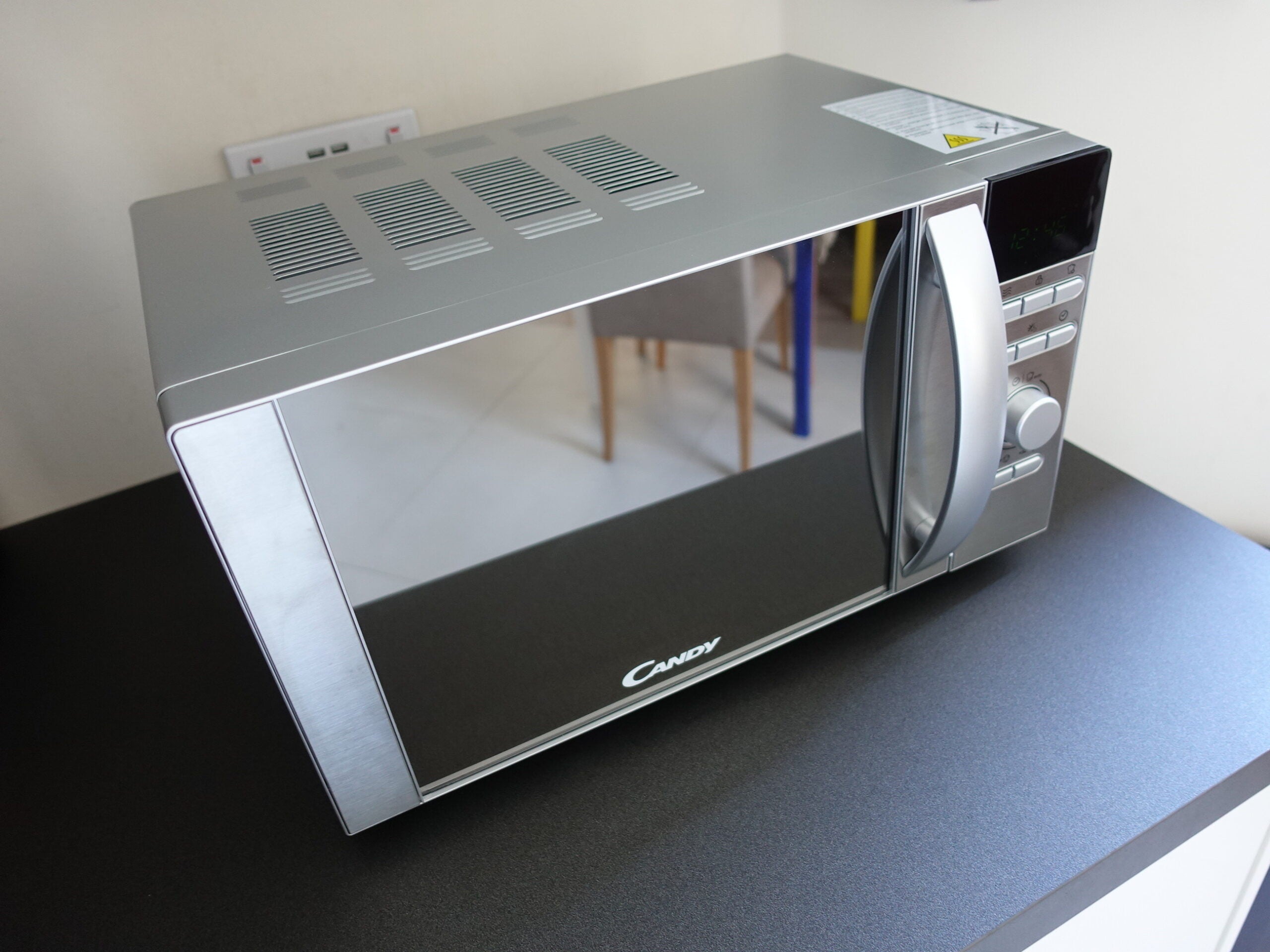Verdict
Some questionable decisions have been made in terms of the design of the Candy CDW20DSS-DX Solo Microwave, including finishes that need constant wiping and the mirror door that is impossible to see through. However, at this capacity and affordable price, the more generous cavity size is a definite plus. Furthermore, this microwave’s handy automatic programmes can calculate your cooking, reheating or defrosting times based on your food’s weight. Memorising the order of the programmes and getting a handle on the controls may take a bit of time, but the food is heated up well and largely evenly.
Pros
- Affordable
- Auto-cook programmes
- Relatively large capacity
Cons
- Attracts fingerprints
- Very dark viewing window
- Not the most intuitive controls
Introduction
The Candy CDW20DSS-DX Solo Microwave is an affordable standalone microwave that boasts some auto-cook programmes as well as weight-adjusted defrosting for up to 1.8kg.
While the buttons take a little getting used to and the visibility through the viewing window is far from great, this appliance stands out from its budget-end peers because of the size of its turntable and cavity, just fitting a 28.5cm dinner plate.
Design And Features
- Viewing window is not transparent enough
- Controls require some getting used to
- Cavity fits dinner plates
The first thing you’ll notice about the Candy CDW20DSS-DX is its shiny door that essentially doubles as a mirror. While the usefulness of a mirror in the kitchen is debatable, it’s also prone to fingerprints – as is the brushed-metal finish used next to it and on the control panel. The silver-coloured plastic handle and buttons, and the metal top and sides of the appliance are comparatively subtle.
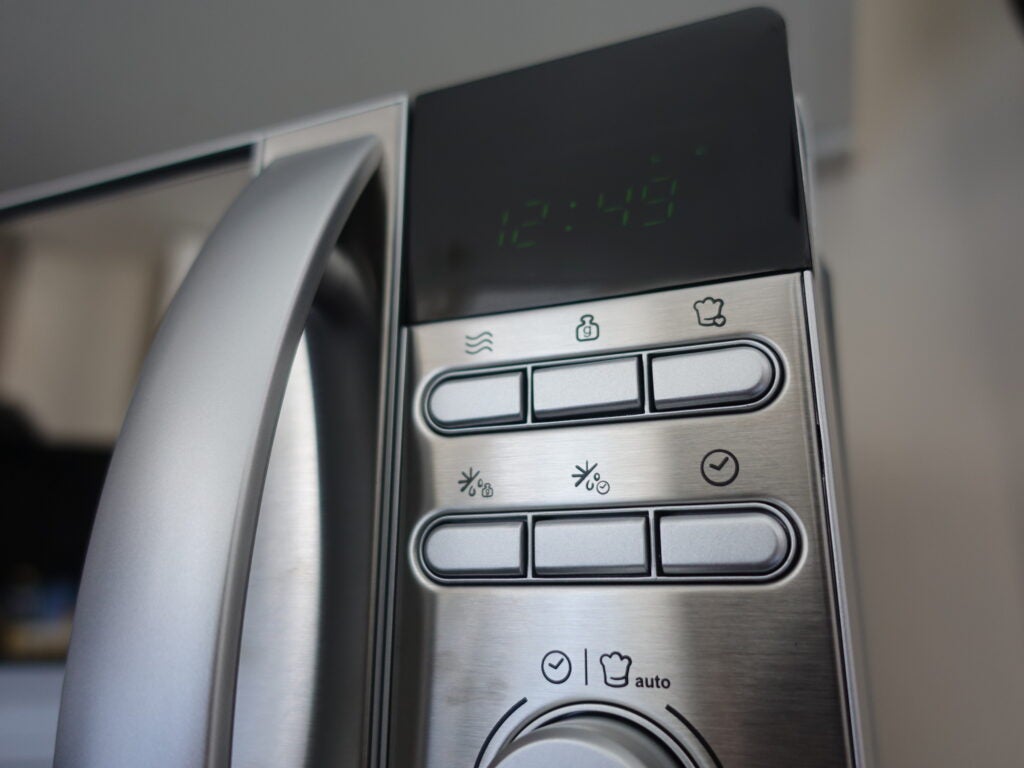
The mirror effect also means that it’s impossible to keep an eye on the food during cooking, as it makes the viewing window too dark to see through even when the internal light is on. So, the only way of checking on your food is actually pausing the microwave by opening the door. Or waiting until it gets dark outside and turning the kitchen lights off.
Carrying on the theme of dimness, the display could also be brighter. Furthermore, while the main numbers are large and legible enough, the icons signifying the activated functions are so small that they essentially require sticking your nose right up to the display.
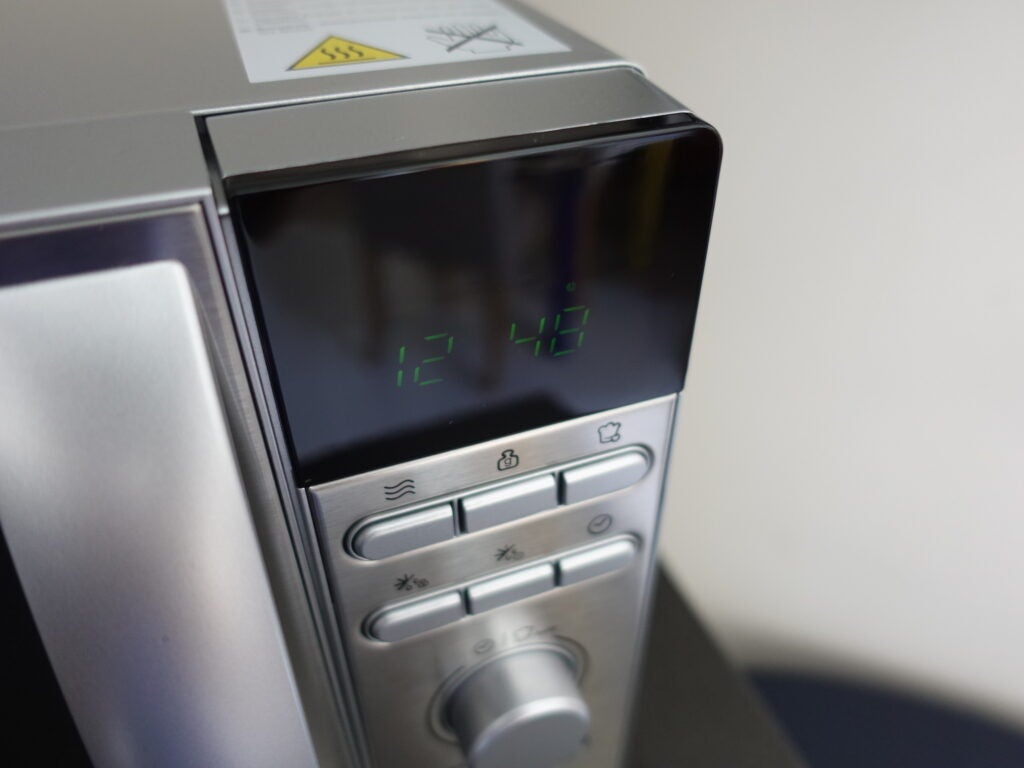
The control buttons include Power (symbolised by waves), Weight Adjust (a weight icon with the letter “g”), Multi-Stage Cooking (a chef’s hat with a heart), Auto Defrost (a melting flake with a weight icon), Speed Defrost (a melting flake with a clock icon), Clock, Stop/Cancel, and Start/Quick Start. Between the latter two and the rest you’ll find the Time/Menu dial.
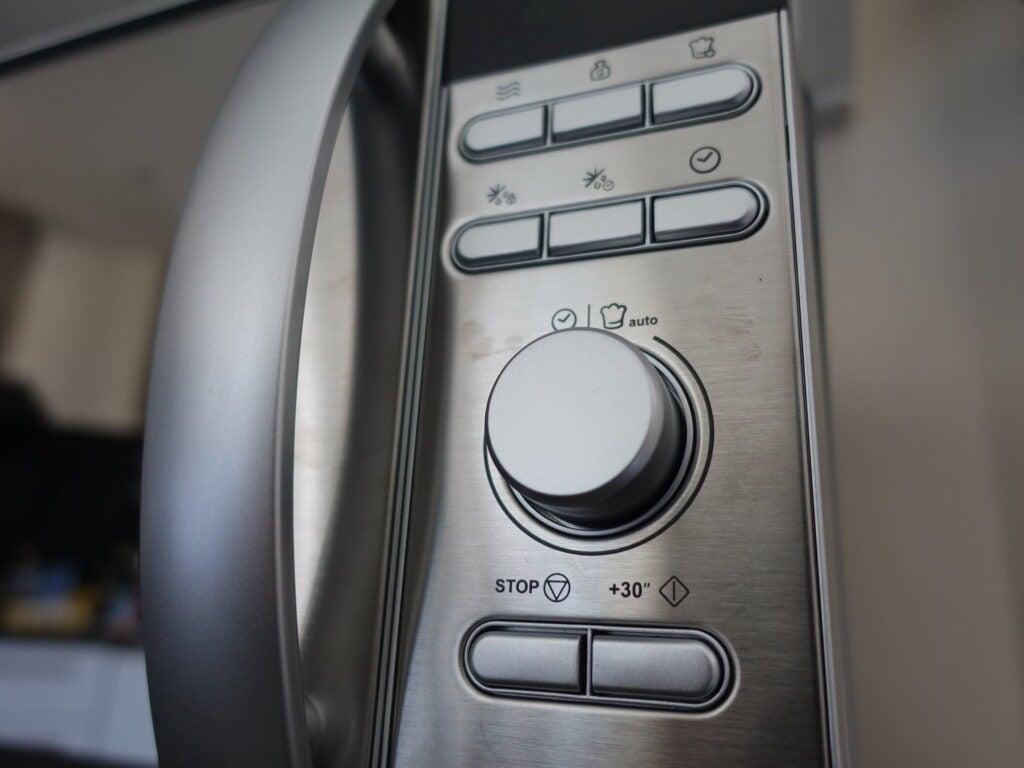
To start cooking, you first need to confirm the power level (0-100% in 20 percentage-point increments) by pressing the Power button, then pick the desired time (in 10sec increments up to 5mins, then in 30sec increments) using the dial, and press the start button. There is also a Quick Start function that lets you begin cooking immediately, but in that case, time is added in 30sec increments by repeatedly pressing the start button.
One of eight auto programmes (Milk/Coffee, Rice, Spaghetti, Potato, Auto Reheat, Fish, Pizza, and Popcorn) can be chosen by turning the dial and setting the correct weight using the Weight Adjust button. On the display, the programmes are represented by numbers only, so you’ll have to check the manual.
As evident from the somewhat difficult-to-spot differences between their tiny icons, the Speed Defrost function is time-based, while the Auto Defrost is weight-based, once again making use of the Weight Adjust button.
The Multi-Stage Cooking function allows you to programme the appliance to raise or lower the power level at a specific point during cooking, but it can’t be combined with the defrosting or auto programmes.
The microwave also has an automatic child lock after a minute of inactivity. All buttons and the dial will stay non-functional until the appliance door is opened.
One definite positive to note here is that for its capacity and price range, the CDW20DSS-DX boasts a large cavity. While a relatively standard 28.5cm dinner plate was the absolute maximum it could fit, the cavities of the 20-litre Beko MOC20100 and the 17-litre Russell Hobbs Scandi Digital Microwave are significantly smaller.
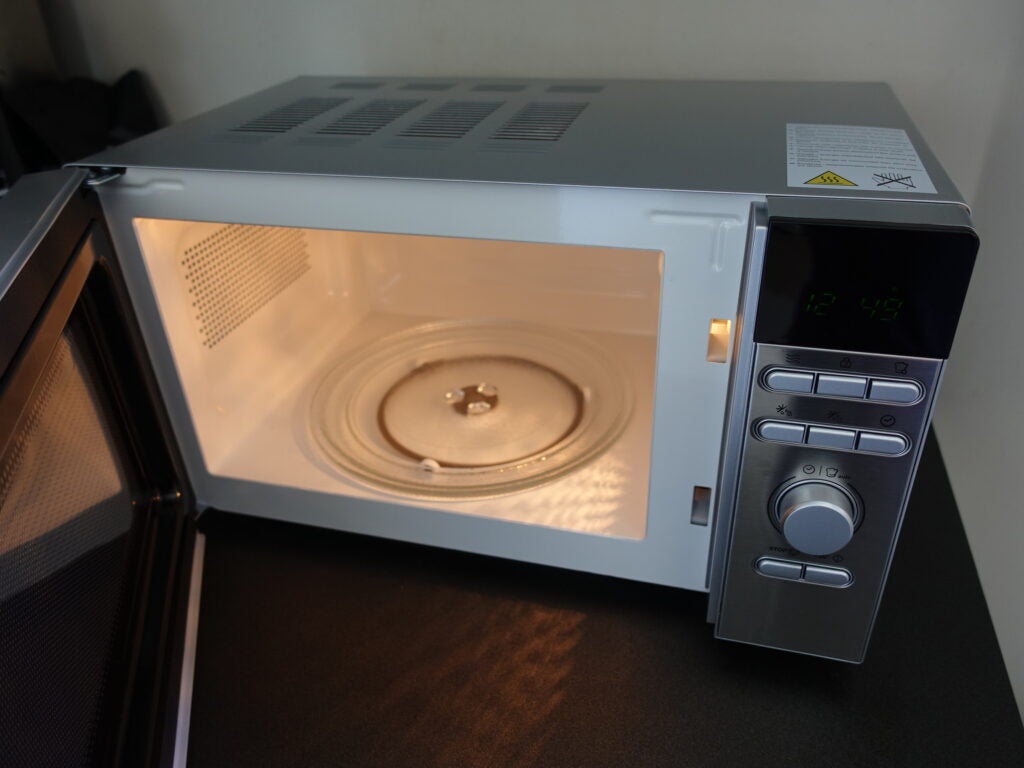
Performance
- Defrosting is fairly even
- Automatic programmes prove handy for cooking and reheating
- Microwaving a raw baking potato takes about 12mins
At 700W, the Candy CDW20DSS-DX isn’t a particularly powerful microwave, requiring longer cooking times for some tasks. However, the results I had were pretty even, meaning there wasn’t much extra cooking time needed after stirring or flipping the food.
First, I defrosted two medium slices of frozen white bread for 1min using the Speed Defrost setting. Both defrosting programmes will pause during the process and remind you to flip the food. After 40secs of defrosting, the microwave alerted me to flip the bread over. At this stage the corners of the slices were warm on my thermal camera, while the middle was cold. After 20secs, the slices still appeared to have a colder centre. Yet, it was only slightly cool and damp to touch – rather than soggy or frozen – and felt perfectly fine for making a sandwich. While the corners stayed warm, there were no apparent hot patches.
I also tried the weight-based Auto Defrost setting, opting for the closest weight available – 100g for two slices of bread that weighed roughly 75g. As this function is likely meant for thicker foods, such as chunks of meat, the total programme time was 5mins30secs. With 1min50secs left, the appliance alerted me to flip the food. On my thermal camera, the results were fairly even – although understandably too warm.
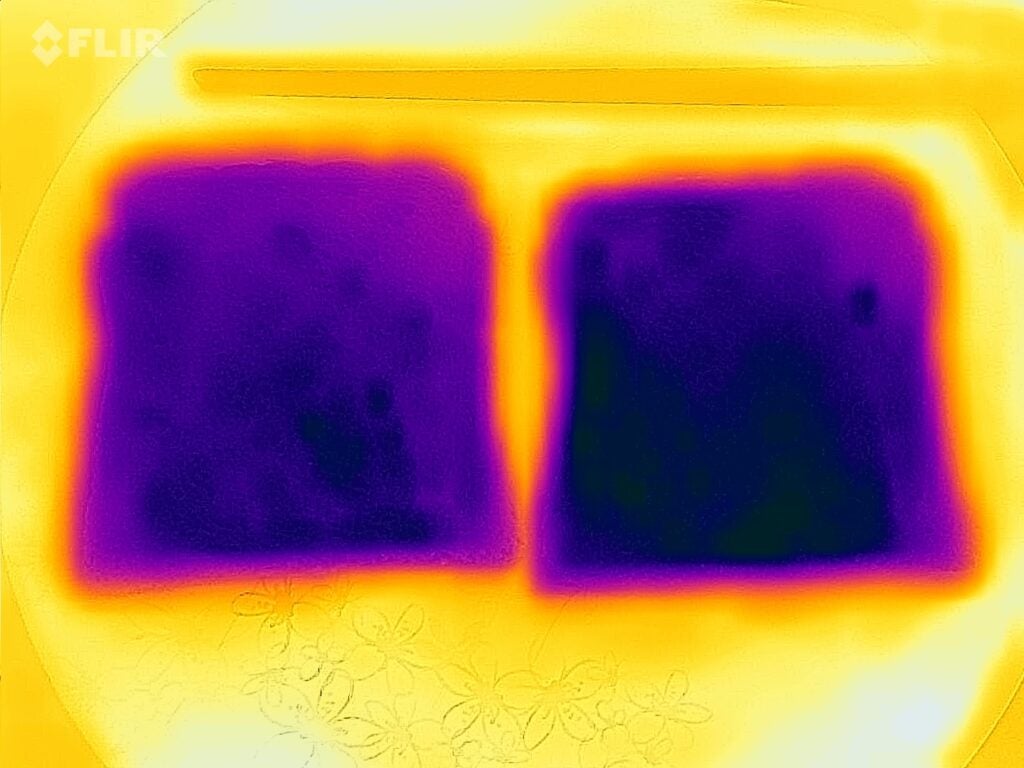
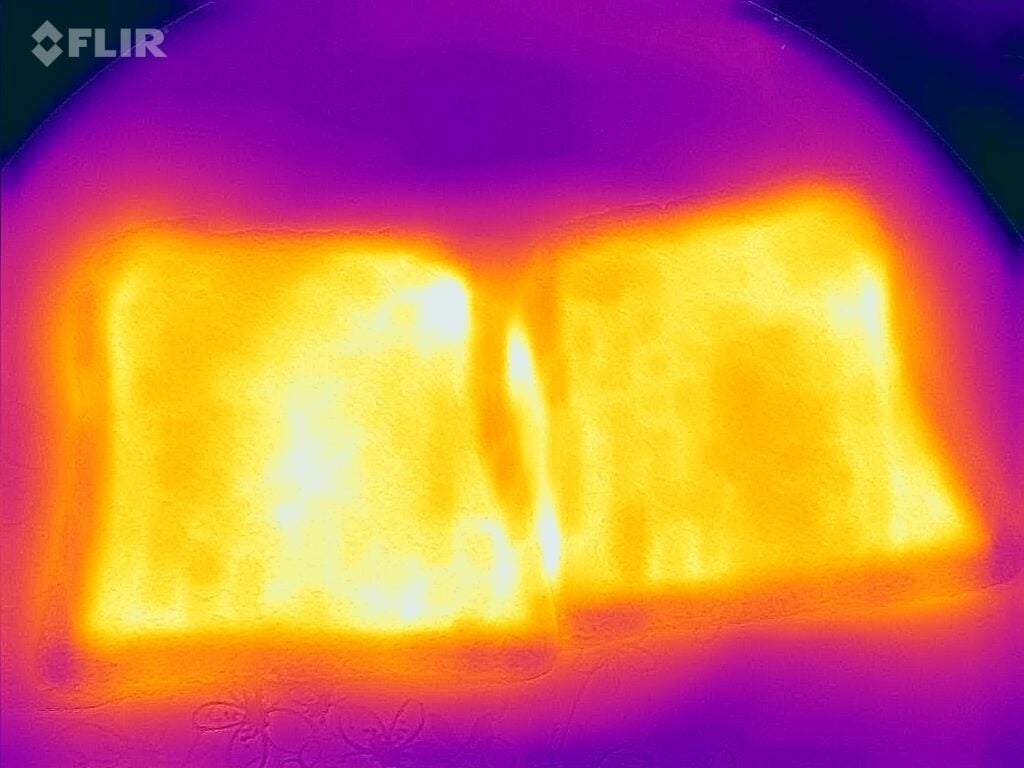
Next up, I tested some auto programmes, starting with programme 2 for rice. There are no specific instructions in the manual for cooking the rice, but I chose the lowest weight available – 150g – and added 300ml of water. It took 20mins and the rice came out with a good texture, which was even better after leaving it to stand in the appliance for a couple of minutes.
After cooling and refrigerating the rice, I used the Auto Reheat programme (5) to reheat 200g of it with two tablespoons of water. For this weight, the appliance suggested 2mins of cooking time. The rice was fairly evenly heated, measuring 95.5°C in the middle and about 85°C around the edges. After giving it a stir, the temperature was still a safe 79°C.
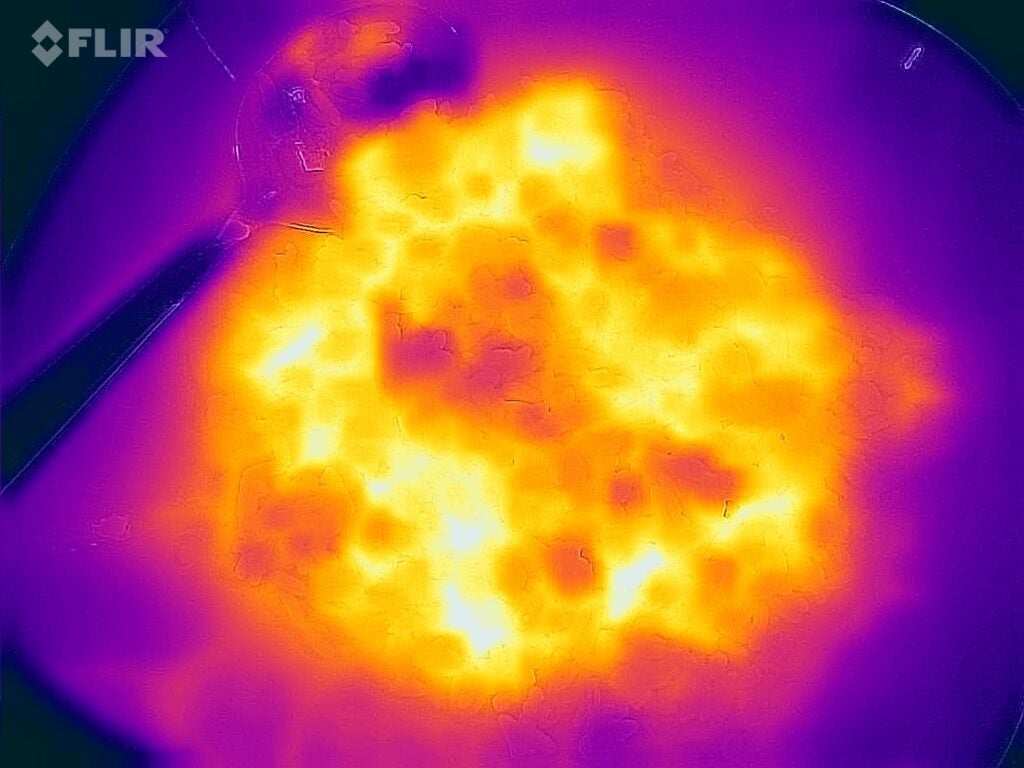
I then turned my attention to cooking a raw 360g baking potato that I’d pricked, oiled and salted. After 8mins at full power, having flipped it halfway through, and letting the potato stand for an additional minute, my temperature probe was still met with crunchy resistance, even though the inside measured 94°C. I flipped the potato again and cooked it for a further 2mins. The centre still felt a little firm when poked with a skewer, although the inner temperature had reached 100.8°C and the potato’s skin was getting wrinkly. When I cut it open, a harder core was still visible on my thermal camera. I put the potato back together and microwaved it for a further minute to reach edible status.
Learning that longer is better, I used the auto programme for potatoes (4). This is one of the few programmes that’s serving-based rather than weight-based, with one serving estimated at 230g and taking 6mins. I had a 330g potato, but decided to run the programme twice, flipping it over between the turns and essentially cooking it for 12mins. After letting the potato stand for a further minute, the skewer went in smoothly and showed 97.5°C. Upon cutting it open, the inside was pleasantly fluffy.
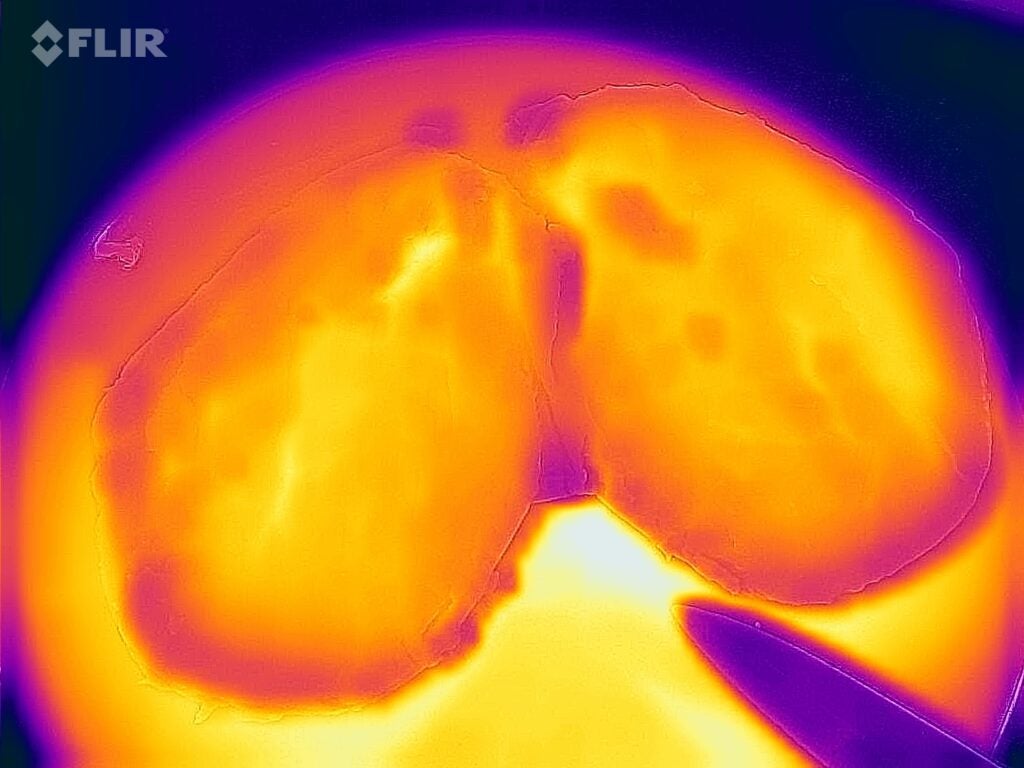
Latest deals
Should you buy it?
If you want an affordable microwave with a decent-sized cavity.
If you don’t want an extra mirror in the kitchen.
Final Thoughts
The Candy CDW20DSS-DX is an affordable microwave, with a couple of handy weight-based programmes for cooking, reheating and defrosting. Compared with the similarly priced Beko MOC20100 and Russell Hobbs Scandi Digital Microwave, it can fit dinner plates of up to 28.5cm.
For those looking for more frills, such as combi or grill functions, the pricier Sharp YC-GC52FU-B or Hotpoint MWH 26321 MB might be a better option.
How we test
Unlike other sites, we test every microwave we review thoroughly over an extended period of time. We use industry standard tests to compare features properly. We’ll always tell you what we find. We never, ever, accept money to review a product.
Find out more about how we test in our ethics policy.
Used as our main microwave for the review period
We use a thermal camera to see how well the microwave can defrost frozen bread, using the defrost setting and any automatic programmes.
We cook a baked potato using just the microwave setting and, if available, another using the combi setting.
If there’s a grill option, we toast bread to see how evenly it cooks.
FAQs
It has 20-litres of space and can big dinner plates.
This is a microwave only.
Verdict
Some questionable decisions have been made in terms of the design of the Candy CDW20DSS-DX Solo Microwave, including finishes that need constant wiping and the mirror door that is impossible to see through. However, at this capacity and affordable price, the more generous cavity size is a definite plus. Furthermore, this microwave’s handy automatic programmes can calculate your cooking, reheating or defrosting times based on your food’s weight. Memorising the order of the programmes and getting a handle on the controls may take a bit of time, but the food is heated up well and largely evenly.
Pros
- Affordable
- Auto-cook programmes
- Relatively large capacity
Cons
- Attracts fingerprints
- Very dark viewing window
- Not the most intuitive controls
Introduction
The Candy CDW20DSS-DX Solo Microwave is an affordable standalone microwave that boasts some auto-cook programmes as well as weight-adjusted defrosting for up to 1.8kg.
While the buttons take a little getting used to and the visibility through the viewing window is far from great, this appliance stands out from its budget-end peers because of the size of its turntable and cavity, just fitting a 28.5cm dinner plate.
Design And Features
- Viewing window is not transparent enough
- Controls require some getting used to
- Cavity fits dinner plates
The first thing you’ll notice about the Candy CDW20DSS-DX is its shiny door that essentially doubles as a mirror. While the usefulness of a mirror in the kitchen is debatable, it’s also prone to fingerprints – as is the brushed-metal finish used next to it and on the control panel. The silver-coloured plastic handle and buttons, and the metal top and sides of the appliance are comparatively subtle.

The mirror effect also means that it’s impossible to keep an eye on the food during cooking, as it makes the viewing window too dark to see through even when the internal light is on. So, the only way of checking on your food is actually pausing the microwave by opening the door. Or waiting until it gets dark outside and turning the kitchen lights off.
Carrying on the theme of dimness, the display could also be brighter. Furthermore, while the main numbers are large and legible enough, the icons signifying the activated functions are so small that they essentially require sticking your nose right up to the display.

The control buttons include Power (symbolised by waves), Weight Adjust (a weight icon with the letter “g”), Multi-Stage Cooking (a chef’s hat with a heart), Auto Defrost (a melting flake with a weight icon), Speed Defrost (a melting flake with a clock icon), Clock, Stop/Cancel, and Start/Quick Start. Between the latter two and the rest you’ll find the Time/Menu dial.

To start cooking, you first need to confirm the power level (0-100% in 20 percentage-point increments) by pressing the Power button, then pick the desired time (in 10sec increments up to 5mins, then in 30sec increments) using the dial, and press the start button. There is also a Quick Start function that lets you begin cooking immediately, but in that case, time is added in 30sec increments by repeatedly pressing the start button.
One of eight auto programmes (Milk/Coffee, Rice, Spaghetti, Potato, Auto Reheat, Fish, Pizza, and Popcorn) can be chosen by turning the dial and setting the correct weight using the Weight Adjust button. On the display, the programmes are represented by numbers only, so you’ll have to check the manual.
As evident from the somewhat difficult-to-spot differences between their tiny icons, the Speed Defrost function is time-based, while the Auto Defrost is weight-based, once again making use of the Weight Adjust button.
The Multi-Stage Cooking function allows you to programme the appliance to raise or lower the power level at a specific point during cooking, but it can’t be combined with the defrosting or auto programmes.
The microwave also has an automatic child lock after a minute of inactivity. All buttons and the dial will stay non-functional until the appliance door is opened.
One definite positive to note here is that for its capacity and price range, the CDW20DSS-DX boasts a large cavity. While a relatively standard 28.5cm dinner plate was the absolute maximum it could fit, the cavities of the 20-litre Beko MOC20100 and the 17-litre Russell Hobbs Scandi Digital Microwave are significantly smaller.

Performance
- Defrosting is fairly even
- Automatic programmes prove handy for cooking and reheating
- Microwaving a raw baking potato takes about 12mins
At 700W, the Candy CDW20DSS-DX isn’t a particularly powerful microwave, requiring longer cooking times for some tasks. However, the results I had were pretty even, meaning there wasn’t much extra cooking time needed after stirring or flipping the food.
First, I defrosted two medium slices of frozen white bread for 1min using the Speed Defrost setting. Both defrosting programmes will pause during the process and remind you to flip the food. After 40secs of defrosting, the microwave alerted me to flip the bread over. At this stage the corners of the slices were warm on my thermal camera, while the middle was cold. After 20secs, the slices still appeared to have a colder centre. Yet, it was only slightly cool and damp to touch – rather than soggy or frozen – and felt perfectly fine for making a sandwich. While the corners stayed warm, there were no apparent hot patches.
I also tried the weight-based Auto Defrost setting, opting for the closest weight available – 100g for two slices of bread that weighed roughly 75g. As this function is likely meant for thicker foods, such as chunks of meat, the total programme time was 5mins30secs. With 1min50secs left, the appliance alerted me to flip the food. On my thermal camera, the results were fairly even – although understandably too warm.


Next up, I tested some auto programmes, starting with programme 2 for rice. There are no specific instructions in the manual for cooking the rice, but I chose the lowest weight available – 150g – and added 300ml of water. It took 20mins and the rice came out with a good texture, which was even better after leaving it to stand in the appliance for a couple of minutes.
After cooling and refrigerating the rice, I used the Auto Reheat programme (5) to reheat 200g of it with two tablespoons of water. For this weight, the appliance suggested 2mins of cooking time. The rice was fairly evenly heated, measuring 95.5°C in the middle and about 85°C around the edges. After giving it a stir, the temperature was still a safe 79°C.

I then turned my attention to cooking a raw 360g baking potato that I’d pricked, oiled and salted. After 8mins at full power, having flipped it halfway through, and letting the potato stand for an additional minute, my temperature probe was still met with crunchy resistance, even though the inside measured 94°C. I flipped the potato again and cooked it for a further 2mins. The centre still felt a little firm when poked with a skewer, although the inner temperature had reached 100.8°C and the potato’s skin was getting wrinkly. When I cut it open, a harder core was still visible on my thermal camera. I put the potato back together and microwaved it for a further minute to reach edible status.
Learning that longer is better, I used the auto programme for potatoes (4). This is one of the few programmes that’s serving-based rather than weight-based, with one serving estimated at 230g and taking 6mins. I had a 330g potato, but decided to run the programme twice, flipping it over between the turns and essentially cooking it for 12mins. After letting the potato stand for a further minute, the skewer went in smoothly and showed 97.5°C. Upon cutting it open, the inside was pleasantly fluffy.

Latest deals
Should you buy it?
If you want an affordable microwave with a decent-sized cavity.
If you don’t want an extra mirror in the kitchen.
Final Thoughts
The Candy CDW20DSS-DX is an affordable microwave, with a couple of handy weight-based programmes for cooking, reheating and defrosting. Compared with the similarly priced Beko MOC20100 and Russell Hobbs Scandi Digital Microwave, it can fit dinner plates of up to 28.5cm.
For those looking for more frills, such as combi or grill functions, the pricier Sharp YC-GC52FU-B or Hotpoint MWH 26321 MB might be a better option.
How we test
Unlike other sites, we test every microwave we review thoroughly over an extended period of time. We use industry standard tests to compare features properly. We’ll always tell you what we find. We never, ever, accept money to review a product.
Find out more about how we test in our ethics policy.
Used as our main microwave for the review period
We use a thermal camera to see how well the microwave can defrost frozen bread, using the defrost setting and any automatic programmes.
We cook a baked potato using just the microwave setting and, if available, another using the combi setting.
If there’s a grill option, we toast bread to see how evenly it cooks.
FAQs
It has 20-litres of space and can big dinner plates.
This is a microwave only.


















